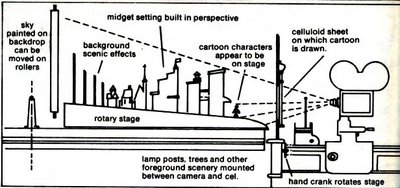

YouTube user, ‘matbergman’, has taken the time to cut together scenes with the setback process used by the Max Fleischer studio. He has a good description of it and gives us the original name here: The rotograph, patent #2054414, was invented by animator Max Fleischer in 1936. Essentially an enormous, revolving, circular miniature set built in forced perspective, it enabled a fantastic sense of depth and parallax in cartoons produced by the Fleischer Studio in the 1930's.
I’ve included the video and some stills showing Max looking through a camera and setback scene, and a line art diagram that kind of explains the process yet again. These really give a striking effect and I’ve often wonder why they weren’t used on Fleischer’s feature works like Gulliver’s Travels and Mr. Bug Goes to Town?
UPDATE: Here is a great scene form a Popeye cartoon. Watch the cages as they turn showing all sides.
https://www.facebook.com/joel.brinkerhoff.9/videos/1314691704956/
Popeye 3D background
Scenes with 3D models for backgrounds like these would completely baffle me as a kid.
Posted by Joel Brinkerhoff on Friday, December 18, 2009
6 comments:
Enjoyed studying this, very good stuff, appreciate it.
Thanks for finally writing about >"Fleischer Setback Process" <Liked it!
Excellent post. I was checking constantly this blog and I'm impressed!
Extremely helpful info particularly the last part :) I care for such info much.
I was looking for this certain info for a long time.
Thank you and good luck.
Joyful Birthday, my fellow January Baby.
Hi, every time i used to check webpage posts here early in the dawn,
for the reason that i like to find out more and
more.
I am pleased to now understand!
Post a Comment